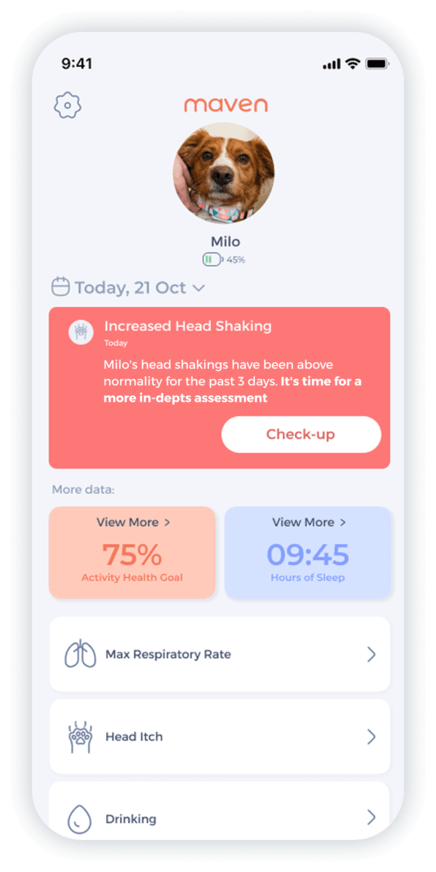Early Signs of Arthritis In Dogs That Aren’t Limping (Vet Verified)
Osteoarthritis is a joint condition that can affect as many as 80% of dogs over the age of 8, which is enough to send any pet parent into a frenzy. The tricky part is understanding the symptoms beyond the obvious limping. After all, limping can be the result of plenty of other issues. Join us as we break down the early signs of arthritis, how to spot them, and help your pooch power through this adversity.
Key takeaways:
- Arthritis often begins with very small behavior changes.
- Limping usually appears later in the process.
- Early veterinary guidance leads to better comfort.
- Simple home adjustments can ease daily strain.
- Tracking activity and heart rate helps identify concerns sooner.
What Is Arthritis in Dogs?

Dog arthritis is a condition in which the joints become inflamed, stiff, and painful because the cartilage that cushions them begins to break down. Cartilage is the smooth padding that lets bones move past one another without pain. What aids it on this mission is the joint fluid, also called synovial fluid. Its job is to keep everything gliding comfortably and without friction.
When arthritis starts, that padding becomes thin or rough, and the joint fluid loses some of its natural slipperiness. This leads to friction, irritation, and a whole lot more effort every time your dog tries to move. The most common form is osteoarthritis, also called degenerative joint disease.
Early Signs of Arthritis in Dogs (Beyond Limping)
Arthritis doesn’t always start with a noticeable limp. In fact, many dogs try to hide discomfort long before their gait gives anything away. Here are some of the quieter, easy-to-miss signs that often show up first:
- Taking longer to get up after resting
- Not so quick to jump on a couch like it used to
- A newly “grumpy” response to being touched around certain joints
- Apparent stiffness during the first few steps in the morning
- Shorter play sessions
- The dog starts slipping more on flat surfaces
- Licking or gently chewing at specific joints
- Choosing to lie down near you instead of following you around the house
Noticing even one of these early changes is worth a quick conversation with your veterinarian, especially if you get the data backing from a pet health app capable of tracking these subtle changes in the dog’s behavior.
“I got the Maven sensor for my 14-year-old Chihuahua mix with heart and trachea issues. It gave me back peace of mind – I can track her RRR, BPM, drinking, and activity anytime and know instantly if something’s wrong. Highly recommend!”

★★★★★
Chiara De Luca
Titti
How to Recognize Joint Pain in Dogs
Most pups won’t limp or cry out right away, which makes recognizing joint pain even more difficult, let alone associating it with arthritis. What dogs actually do is they quietly adjust how they move or behave, hoping you won’t notice. Here’s how veterinarians and researchers describe those early signs, in plain, everyday language.
- They start slowing down: If they are not as willing to perform certain activities that they used to, like running up and down the stairs, that hesitation is one of the earliest red flags.
- They’re stiff after a nap: If it takes a few steps to “warm up” in the morning, that’s a classic early sign.
- Their posture looks off: If your dog is shifting its weight forward, sitting crooked, or moving in a slightly guarded way, it could be due to joint pain.
- They fuss over certain joints: Repeated licking or gentle chewing at the same spot can mean something’s bothering them.
- Getting up and lying down becomes a project: Slow, careful movements during these transitions are often one of the first things owners notice.
Osteoarthritis in Dogs: Why It’s So Common
Osteoarthritis is incredibly common in dogs simply because their joints work hard every single day. Over time, all that running, jumping, twisting, and playing puts natural wear on the cartilage and joint fluid that keep movement smooth. Add in a few extra risk factors like aging, carrying a little too much weight, past injuries, or certain breed tendencies, and you get a recipe for arthritis.
When to See a Vet and What a Diagnosis Involves

“Many dogs show early signs of arthritis long before they start limping — subtle changes in energy, posture, or behavior often come first.” — Carolina Domingues, DVM, Veterinarian at Maven Pet
Don’t wait for a limp to kick in (no pun intended) to react. If you see signs of slowing down and reluctance to move, pick up the phone and call the vet. The earlier your vet sees what’s going on, the easier it is to manage joint pain before it becomes a daily struggle.
A typical arthritis workup is pretty straightforward. Your vet will start with a hands-on exam to check joint flexibility, muscle tone, and any areas of heat or swelling. They’ll also ask about changes you’ve seen at home, which is often just as important as what they find in the clinic. From there, they may recommend X-rays to look at joint spacing, bone changes, or signs of inflammation. Some clinics also use gait analysis or bloodwork to rule out other conditions, depending on the dog.
Managing Arthritis at Home
Caring for a dog with arthritis at home is all about making daily life gentler on their joints and supporting their comfort. Here’s how to do it.
Weight Management
Keeping your dog at a healthy weight is one of the most powerful things you can do. Less body weight means less pressure on already sore joints and an improvement in moving around.
Low-Impact Exercise
Regular, gentle movement helps keep joints flexible. Short walks or controlled play sessions are usually better than long, high-intensity outings.
Supportive Bedding
A soft bed gives your dog a comfortable place to rest and reduces pressure on stiff joints, especially overnight. If you can get your hands on an orthopedic mattress, it’s a big plus.
Ramps and Home Modifications
Small changes like adding ramps, using non-slip rugs, or blocking off steep stairs can make your dog’s day much easier and safer.
Monitoring and Routine Check-Ins
Tracking changes in mobility, posture, and behavior helps you notice when something shifts. Leveraging the power of a pet health tracker and doing regular vet visits will keep your dog’s care plan on the right track.
How Maven Pet Helps Track Mobility and Heart Rate Changes Linked to Joint Pain
Maven’s dog health tracker makes it much easier to notice those tiny changes that often come before obvious arthritis signs. The collar’s light sensor tracks your dog’s movement all day and converts it into readable activity events rather than confusing numbers.


Monitor heart rate, respiratory rate, activity & rest, drinking, itch behavior.
Because it learns your dog’s regular routine, you can quickly see when they’re slowing down, resting more, or skipping the kind of play they usually love. Weekly and monthly trend views make those shifts pop out, and the quick in-app checkups help you figure out whether it’s the weather, a busy day, or something worth watching more closely.
Maven’s heart rate tracking adds another helpful clue. It automatically collects resting heart rate samples and builds a normal range just for your dog. If joint discomfort is brewing, their heart rate often changes before you’d catch anything outwardly. Maven highlights those off days, shows clean trendlines you can share with your vet and helps them diagnose OA.
Conclusion
Catching arthritis early can make a world of difference for your dog’s comfort and long-term mobility. With arthritis, the dog’s joints can be under a lot of stress without you even knowing, which is why watching for subtle shifts in movement, behaviour, and energy, and involving your veterinarian early, can help you stay ahead of pain.
Your ally in that fight is Maven Pet’s health tracker, with all its movement, heart rate, and other tracking features that can help you keep your dog feeling good for years to come.
Maven Pet focuses on improving the quality of life of our pets with technology, using artificial intelligence (AI) to enable proactive pet care. By accurately collecting and monitoring pet data 24/7 and flagging any irregularities, Maven Pet empowers pet parents and veterinarians to stay ahead of potential health issues, ensuring the well-being and longevity of our beloved companions.




